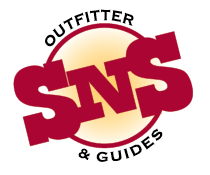Wyoming Backcountry Elk Camp Experience "Somewhere in the vast Western Wyoming backcountry, time slows. Brisk morning air, steep trails, dusty horse hooves, the bugle of a distant bull elk, snow capped peaks, and rivers divide. The kind of hunt your grandpa remembers isn't just a memory, it's alive, waiting for you to experience it for yourself." SNS Outfitter & Guides is proud to offer traditional wilderness elk hunting adventures. We invite you to experience the rhythm of the wilderness, t...
Rifle Season Meets the Rut: Hunting During Wyoming’s Peak Rut
SNS Outfitter is proud to announce an exciting and unique hunting opportunity. Most elk areas in Wyoming reserve the September elk rut for archery hunting. Starting in 2026 we will be offering an outstanding September elk hunt. Our hunters can now hunt with a rifle during the peak of the elk rut. Adding to our current two wilderness camps a third camp with a rifle season starting September 20 will be available for our hunters. Elk hunters agree, the thrill of hunting elk during the bugle season ...
Wilderness Elk Hunting: The Way Grandpa used to do it
For more than 40 years, SNS Outfitter & Guides has been leading unforgettable Wyoming elk hunting experiences. Over those decades, we've watched hunting evolve from the gear and travel preferences to the type of experiences hunters crave most. These days, more and more hunters are turning back the clock and seeking a classic wilderness elk hunt, the kind of adventure Grandpa used to talk about. The Shift Toward Wilderness Hunts Back in the 1990s, private land elk hunts were the big trend. Co...
How to Prepare for Wyoming’s High Elevation Hunts
If you are joining us for a hunt in Wyoming or Montana, chances are you will be spending time at elevations much higher than what you are used to. Casper sits at about 5,150 feet above sea level and is home to most of our antelope hunts along with some of our deer hunts. Many of our elk camps sit between 7,000 and 8,000 feet, and in some areas we hunt as high as 9,500 feet. For hunters coming from lower elevations, that change can be a shock to the body. Knowing how to prepare and what to ...
Hunting out West for Big Game; 48 seasons of excellence with SNS Outfitter & Guides
Welcome to the West; where elk bugles echo through the timber, mule deer slip through the sagebrush, and antelope race across the open prairie. For 48 years, SNS Outfitter & Guides has led big game hunters into the wild beauty of Wyoming and Montana, helping them turn dreams into unforgettable memories. Whether you're booked for a fall hunt or simply living for the moment you finally get out West, this video brings the action, scenery, and spirit of hunting season straight to your screen. El...
Retreat to Sheep Trap Elk Hunting Camp
At the start of last fall's elk season, the SNS Outfitter & Guides board of directors saddled up and rode into one of our most storied wilderness elk camps, affectionately known as "Sheep Trap". This trip wasn't about hunting, it was about experiencing, firsthand, the very same journey that our clients make when they step into the Washakie Wilderness with our team. Seven miles of easy trail, lined with sweeping views and abundant wildlife, carried them into camp where adventure,...
Hunting Optics: What You Need for Western Big Game in Wyoming & Montana
What You Need for Western Big Game in Wyoming & Montana Have you ever wondered what optics you actually need for a western big game hunt? From elk in the timber to antelope on the prairie, success starts with having the right glass. In this SNS Outfitter Classroom session, Miss Heather calls in a "substitute teacher". Meet Jesse Burd of Rocky Mountain Discount Sports. Jesse breaks down the essentials: binoculars, rangefinders, and spotting scopes. What to look for, how to use them...
A Historic Wyoming Grizzly Bear Season on the Horizon
Written by Sy Gilliland, Founder SNS Outfitter & Guides The stars seem to be aligning for Wyoming to hold a historic grizzly bear hunting season in the very near future. Several key Wyoming leaders have been appointed to high-level roles within the U.S. Department of the Interior and the U.S. Fish and Wildlife Service (USFWS), signaling a possible shift in grizzly bear management. Among them is Karen Budd-Falen, a prominent Cheyenne attorney with extensive experience in public land iss...
Mastering the Shot:
Shooting Skills Every Western Hunter Needs If you're heading out West for your first (or next) big game hunt, your rifle skills matter more than you might think. A clean, ethical shot often comes down to how well you've practiced—and practiced right. In this video, SNS Outfitter & Guides walks you through real-world shooting positions that mimic the conditions you'll encounter in the field. Heather, our Director of Media & Marketing, demonstrates the typical western shooting setups—sitti...
Celebrating 15 Years with Ambrosia: The Woman Behind the Hunts at SNS Outfitter & Guides
Time flies when you're doing what you love. On June 15, 2025, we celebrated 15 years of Ambrosia at SNS Outfitter and Guides. She started with us on June 15, 2010, as a part-time bookkeeper and office manager. At the time, her kids were just 10, 8, and 5. What began as a flexible position for a young mom quickly turned into a full-time role. Somewhere along the way, she made the job her own. Today, all three of her kids are grown and out in the world, and she's now a proud grandma to a one-year-...
SNS Outfitter & Guides is a permittee of the Bridger Teton National Forest, Greys River District & Thunder Basin National Grasslands as well as the Bureau of Land Management.
Outfitter Web Site Design by Waves Web Design.
